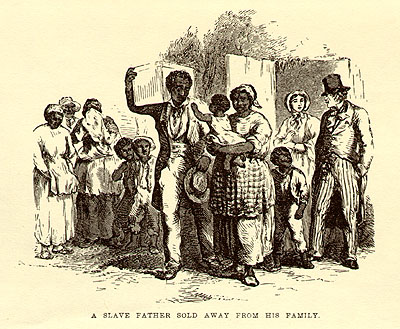| << Chapter < Page | Chapter >> Page > |
Slave auction block

Understanding the economic details of slave sales is important, but educators can also push their students to contemplate what George or Milly might have experienced on an auction block in a locale such as New Orleans. At this juncture, historical images of slave auctions could be shown, perhaps read alongside accounts provide by the American Slave Narrative project, available online. These slave narratives provide detailed remembrances of the sale process. The slave pens, where slaves were held before and after auctions, have been described as particularly horrid. Walter Johnson in his study of the New Orleans slave market states, “The walls surrounding the pens were so high-fifteen or twenty feet-that one New Orleans slave dealer thought they could keep out the wind”(2). Despite this brutal environment, slaves were still pushed to lie and cajole possible purchasers at a moment’s notice. Johnson contends, “Slaves who had run away or been ill were told to hide their histories”(130).
Family disruption

In addition, educators can use the bills of sale as a transition into a discussion of slave families. A sale often meant the breaking up of a family arrangement. Using sources such as Ann Patton Malone’s Sweet Chariot (1992) and Larry Hudson, Jr.’s To Have and to Hold (1997), educators can describe how slaves were able to form loving family situations. Then, the threat of sale can be placed alongside other forms of brutality used against enslaved peoples. As Hudson, Jr. states, “A common tactic used by planters to control their labor force was the threat of sale”(168). Furthermore, those individuals being sold, such as George or Milly, would then face the challenge of establishing a new life in a foreign locale. Students can be asked to contemplate how the sale process from threat to relocation could have impacted daily life for an enslaved individual. As an addition to the above exercise, educators can assign one of the many lesser known studies of individual slave experiences, such as In Search of the Promised Land (2006), the story of Sally Thomas’s quest for a free family life.
Bibliography
Bergrad, Laird, and García, Fe Iglesias, and Barcia, María del Carmen. The Cuban Slave Market, 1790-1880 . New York: Cambridge University Press, 1995.
Franklin, John Hope and Loren Schweninger. In Search of the Promised Land: A Slave Family in the Old South . New York: Oxford University Press, 2006.
Hudson, Jr., Larry E. To Have and to Hold: Slave Work and Family Life in Antebellum South Carolina . Athens: University of Georgia Press, 1997.
Johnson, Walter. Soul by Soul: Life Inside the Antebellum Slave Market . Cambridge: Harvard University Press, 1999.
Jones, Jacqueline. Labor of Love, Labor of Sorrow: Black Women, Work, and the Family, from Slavery to the Present . New York: Vintage Books, 1985.
Malone, Ann Patton. Sweet Chariot: Slave Family and Household Structure in Nineteenth-Century Louisiana . Chapel Hill: University of North Carolina Press, 1992.
Stevenson, Brenda E. Life in Black and White: Family and Community in the Slave South . New York: Oxford University Press, 1996.

Notification Switch
Would you like to follow the 'Slavery in the americas' conversation and receive update notifications?